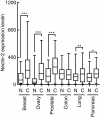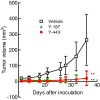Nectin-2 is a potential target for antibody therapy of breast and ovarian cancers
- PMID: 23758976
- PMCID: PMC3698035
- DOI: 10.1186/1476-4598-12-60
Nectin-2 is a potential target for antibody therapy of breast and ovarian cancers
Abstract
Background: Nectin-2 is a Ca(2+)-independent cell-cell adhesion molecule that is one of the plasma membrane components of adherens junctions. However, little has been reported about the involvement of Nectin-2 in cancer.
Methods: To determine the expression of Nectin-2 in cancer tissues and cancer cell lines, we performed gene expression profile analysis, immunohistochemistry studies, and flow cytometry analysis. We also investigated the potential of this molecule as a target for antibody therapeutics to treat cancers by generating and characterizing an anti-Nectin-2 rabbit polyclonal antibody (poAb) and 256 fully human anti-Nectin-2 monoclonal antibodies (mAbs). In addition, we tested anti-Nectin-2 mAbs in several in vivo tumor growth inhibition models to investigate the primary mechanisms of action of the mAbs.
Results: In the present study, we found that Nectin-2 was over-expressed in clinical breast and ovarian cancer tissues by using gene expression profile analysis and immunohistochemistry studies. Nectin-2 was over-expressed in various cancer cell lines as well. Furthermore, the polyclonal antibody specific to Nectin-2 suppressed the in vitro proliferation of OV-90 ovarian cancer cells, which express endogenous Nectin-2 on the cell surface. The anti-Nectin-2 mAbs we generated were classified into 7 epitope bins. The anti-Nectin-2 mAbs demonstrated antibody-dependent cellular cytotoxicity (ADCC) and epitope bin-dependent features such as the inhibition of Nectin-2-Nectin-2 interaction, Nectin-2-Nectin-3 interaction, and in vitro cancer cell proliferation. A representative anti-Nectin-2 mAb in epitope bin VII, Y-443, showed anti-tumor effects against OV-90 cells and MDA-MB-231 breast cancer cells in mouse therapeutic models, and its main mechanism of action appeared to be ADCC.
Conclusions: We observed the over-expression of Nectin-2 in breast and ovarian cancers and anti-tumor activity of anti-Nectin-2 mAbs via strong ADCC. These findings suggest that Nectin-2 is a potential target for antibody therapy against breast and ovarian cancers.
Figures













Similar articles
-
Fc engineering of anti-Nectin-2 antibody improved thrombocytopenic adverse event in monkey.PLoS One. 2018 May 3;13(5):e0196422. doi: 10.1371/journal.pone.0196422. eCollection 2018. PLoS One. 2018. PMID: 29723247 Free PMC article.
-
The anti-tumor efficacy of 3C23K, a glyco-engineered humanized anti-MISRII antibody, in an ovarian cancer model is mainly mediated by engagement of immune effector cells.Oncotarget. 2017 Jun 6;8(23):37061-37079. doi: 10.18632/oncotarget.15715. Oncotarget. 2017. PMID: 28427157 Free PMC article.
-
Nectin-4: a new prognostic biomarker for efficient therapeutic targeting of primary and metastatic triple-negative breast cancer.Ann Oncol. 2017 Apr 1;28(4):769-776. doi: 10.1093/annonc/mdw678. Ann Oncol. 2017. PMID: 27998973
-
Nectin cell adhesion molecule-4 (NECTIN-4): A potential target for cancer therapy.Eur J Pharmacol. 2021 Nov 15;911:174516. doi: 10.1016/j.ejphar.2021.174516. Epub 2021 Sep 20. Eur J Pharmacol. 2021. PMID: 34547246 Review.
-
Nectin-4-directed antibody-drug conjugates (ADCs): Spotlight on preclinical and clinical evidence.Life Sci. 2024 Sep 1;352:122910. doi: 10.1016/j.lfs.2024.122910. Epub 2024 Jul 11. Life Sci. 2024. PMID: 39002610 Review.
Cited by
-
TIGIT: A promising target to overcome the barrier of immunotherapy in hematological malignancies.Front Oncol. 2022 Dec 20;12:1091782. doi: 10.3389/fonc.2022.1091782. eCollection 2022. Front Oncol. 2022. PMID: 36605439 Free PMC article. Review.
-
Analysis of Protein-Protein Interactions Identifies NECTIN2 as a Target of N,N-Bis (5-Ethyl-2-hydroxybenzyl) Methylamine for Inhibition of Lung Cancer Metastasis.Cancer Genomics Proteomics. 2022 Sep-Oct;19(5):624-635. doi: 10.21873/cgp.20347. Cancer Genomics Proteomics. 2022. PMID: 35985690 Free PMC article.
-
Mining Featured Biomarkers Linked with Epithelial Ovarian CancerBased on Bioinformatics.Diagnostics (Basel). 2019 Apr 9;9(2):39. doi: 10.3390/diagnostics9020039. Diagnostics (Basel). 2019. PMID: 30970615 Free PMC article.
-
DNAM-1 chimeric receptor-engineered NK cells: a new frontier for CAR-NK cell-based immunotherapy.Front Immunol. 2023 Jun 8;14:1197053. doi: 10.3389/fimmu.2023.1197053. eCollection 2023. Front Immunol. 2023. PMID: 37359555 Free PMC article.
-
PVRIG is a novel natural killer cell immune checkpoint receptor in acute myeloid leukemia.Haematologica. 2021 Dec 1;106(12):3115-3124. doi: 10.3324/haematol.2020.258574. Haematologica. 2021. PMID: 33147937 Free PMC article.
References
-
- Satoh-Horikawa K, Nakanishi H, Takahashi K, Miyahara M, Nishimura M, Tachibana K, Mizoguchi A, Takai Y. Nectin-3, a new member of immunoglobulin-like cell adhesion molecules that shows homophilic and heterophilic cell-cell adhesion activities. J Biol Chem. 2000;275:10291–10299. doi: 10.1074/jbc.275.14.10291. - DOI - PubMed
MeSH terms
Substances
LinkOut - more resources
Full Text Sources
Other Literature Sources
Medical
Molecular Biology Databases
Miscellaneous

